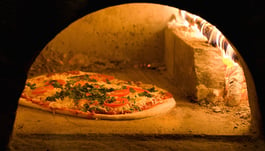 Double, double, toil and trouble. Ovens burn, and crust bubble! OK, Shakespeare’s witches didn’t say that exactly. But they weren’t making pizza in a high-heat oven, were they?
Double, double, toil and trouble. Ovens burn, and crust bubble! OK, Shakespeare’s witches didn’t say that exactly. But they weren’t making pizza in a high-heat oven, were they?
We know that high-heat ovens have been producing perfect pizzas for decades. So, too much crust bubbling and burning must be the fault of the crust itself, right? Well…it depends.
Crust bubbling is the natural result of fermenting yeast and sugar trapping carbon dioxide in the dough, which expands when heated. While small bubbles are expected from high-heat oven baking, large bubbles can overtake a pizza, making toppings slide and leading to unattractive pies and unhappy customers.
Lightly charred crusts from brick- or wood-fired ovens are appetizing. Burnt crusts from some other high-heat ovens are not. In addition to checking your three “T”s — type (of oven), temperature, and timing — be sure to keep these pointers in mind so burning doesn’t turn off your customers and scorch your profits.
1. Properly Proof Your Dough
Even the perfect dough can result in many crust bubbles if it’s underproofed, while overproofed dough results in a crust that’s too flat. To get proofing right, follow these five steps:
- Making your own dough? Prevent drying by scaling, balling, and wiping your dough balls with salad oil. If you’re using pre-made dough balls, this step is already done.
- Evenly space dough balls on a large baking sheet; cross-stack them in dough boxes for two hours.
- Down-stack the dough balls and place them in a cooler at 34° to 40° F.
- Cool them for at least 24 hours; 48-72 hours is better.
- Check the dough; it’s perfectly proofed when it has doubled in size and is slightly yellow.
2. Show Dough Patience
It’s important to let your dough warm slightly at room temperature before forming a crust. If you use it directly from the cooler, it encourages bubbling. So, allow for up to an hour at room temperature prior to opening into skins.
3. Control Your Bubbling
Two simple devices can help control — not prevent — bubbling. A dough docker (a spiked rolling pin) gets rid of extra bubbles when you’re pushing your dough ball to form the crust.
Tip: Carefully watch that sauce doesn’t bleed through the crust.
The other device is a long-handled bubble popper that reaches into the oven during baking, if that’s possible with the high-heat oven you use.
4. Don’t Get Burned
This is a burn prevention option that does have to do specifically with the crust itself. It’s the sugar content of the dough, which affects bake times. The higher the sugar content, the less baking time required. The opposite is true for dough with low (or no) sugar content.
5. Dough Ball Solutions
It’s true that some pizza doughs have a tough time in high-heat ovens while others are specifically formulated for them. Alive & Kickin' Pizza Crust has two ideal options, both of which are mainstays for managing pizza prep time and crust production consistency:
Wood-Fired New York Style Dough Balls withstand the high temperatures in wood-fired ovens to create a perfectly crisp and brown outside with a slightly chewy texture.
Classic Neapolitan Dough Balls are made from imported Italian flour (00) to perform well in high-heat ovens of 600˚ F and higher.
High-heat ovens can mean high customer loyalty and high profits, especially if you use the right crusts and dough balls. Our guide, The Best Crust Types for Your Pizzeria's Oven, explores this and many other factors to help you make an informed decision. Click the button below to access your copy now!





